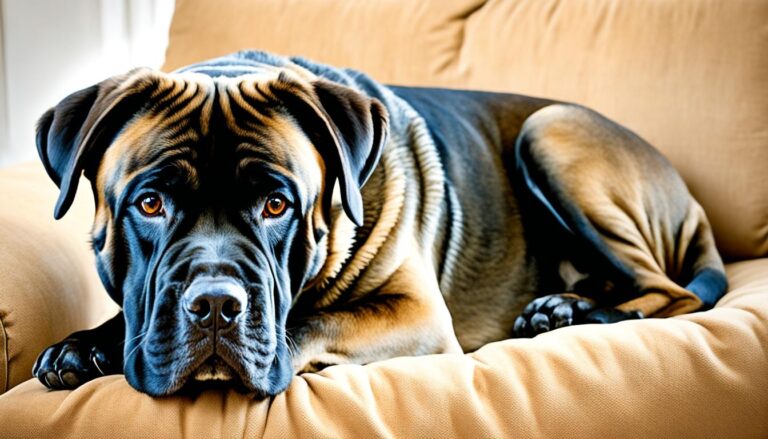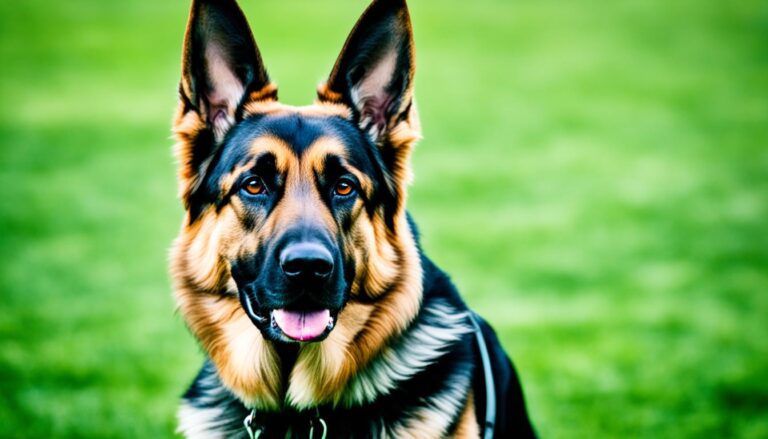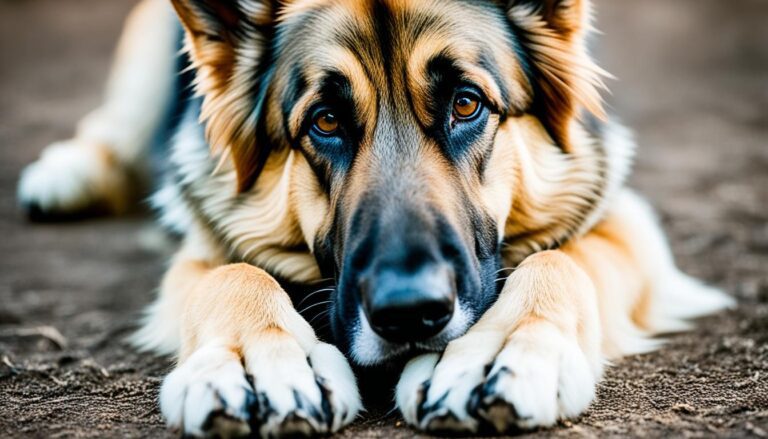German Shepherd Heat Cycle Frequency Guide
Did you know that female German Shepherds have an average of two heat cycles per year? That’s right! The German Shepherd heat cycle, also known as estrus, is a significant part of their reproductive cycle. If you own a female German Shepherd or are considering getting one, it’s essential to understand their heat cycle and how to manage it to ensure their health and well-being.
Signs of a German Shepherd in Heat
When it comes to determining if your German Shepherd is in heat, there are several observable signs to look out for. These signs can help you identify the different stages of the heat cycle and understand your dog’s reproductive behavior.
Proestrus Stage
During the proestrus stage, you may notice certain physical changes in your German Shepherd. One of the most prominent signs is the swelling of the vulva, which becomes more apparent during this stage. Additionally, your dog may experience vaginal bleeding. This bleeding can vary in intensity and duration, but it is typically heavier at the beginning of the heat cycle and gradually decreases.
Another notable sign is increased urination. Your German Shepherd may urinate more frequently during this stage.
Estrus Stage
As the heat cycle progresses into the estrus stage, the bleeding becomes lighter in color. This stage is when your German Shepherd is fertile and receptive to mating. A distinct behavior during this stage is “flagging.” Flagging refers to the act of raising the tail or rubbing the rear end against objects. This behavior is a clear indication that your German Shepherd is ready to mate.
Behavioral Changes
In addition to the physical signs, you may also notice behavioral changes in your German Shepherd when she is in heat. These changes can include increased clinginess, restlessness, excitability, and seeking attention. It is important to be aware of these behavioral shifts and provide extra care and comfort to your dog during this time.
Remember, each German Shepherd may exhibit slightly different signs and behaviors during their heat cycle. Monitoring your dog closely and familiarizing yourself with these signs will help you better understand her reproductive cycles and make informed decisions regarding breeding or preventing unwanted pregnancies.

| Stage | Signs |
|---|---|
| Proestrus | Swollen vulva, vaginal bleeding, increased urination |
| Estrus | Lighter bleeding, receptive to mating, “flagging” behavior |
| Behavioral Changes | Increased clinginess, restlessness, excitability |
Managing a German Shepherd in Heat
When a German Shepherd is in heat, it is important to take extra care to prevent unwanted pregnancies. We understand the significance of managing your German Shepherd’s heat cycle and ensuring their well-being. Here are some measures you can take to care for your German Shepherd in heat and prevent pregnancy.
Separating from male dogs
To minimize the risk of unplanned breeding, it is recommended to keep your female German Shepherd separated from male dogs for at least 21 days. This period allows for the completion of the heat cycle and reduces the chances of accidental mating.
Using dog diapers or pants
Protecting your German Shepherd from mating and avoiding furniture and carpet stains can be done by using dog diapers or pants. These accessories provide an effective barrier and help maintain cleanliness during the heat cycle.
Increasing attention and exercise
During the heat cycle, your female German Shepherd may experience changes in behavior. Increased clinginess and excitability are common. Providing extra attention and engaging them in sufficient exercise can help manage their energy levels and alleviate any restlessness.
Creating a secure environment
Preventing accidental mating requires keeping your German Shepherd in a secure environment. Ensuring proper confinement within your property and vigilant supervision during walks are crucial in minimizing the risk of unwanted pregnancy.
Remember: Prevention is key in managing a German Shepherd in heat. Take proactive measures to keep your female dog safe and prevent any unintended litters.
Consider spaying
If breeding is not desired, spaying your German Shepherd is a highly recommended option. Spaying eliminates future heat cycles and significantly reduces the chances of reproductive health problems. Consult with a veterinarian to discuss the best timing and suitability for your dog.
| Measures for Managing a German Shepherd in Heat | Benefits |
|---|---|
| Keeping the female separate from male dogs | – Prevents unplanned breeding |
| Using dog diapers or pants | – Protects from mating – Prevents furniture and carpet stains |
| Increasing attention and exercise | – Manages behavior changes – Alleviates restlessness |
| Creating a secure environment | – Minimizes the risk of accidental mating |
| Consider spaying | – Eliminates future heat cycles – Reduces reproductive health risks |
Conclusion
The German Shepherd heat cycle is a natural process that occurs in female German Shepherds, and understanding its frequency and stages is essential for responsible pet owners. By monitoring the signs of a German Shepherd in heat and taking appropriate measures, we can effectively manage their heat cycles and prevent unwanted pregnancies.
To manage a German Shepherd in heat, it is recommended to keep the female separated from male dogs for at least 21 days, unless breeding is intended. Using dog diapers or pants can also help protect the female and prevent any staining of furniture and carpets.
Preventing unwanted pregnancies in German Shepherds can be achieved through spaying, which is a highly recommended option. Spaying not only prevents future heat cycles but also helps avoid potential health problems associated with reproduction.
Remember, consulting with a veterinarian is crucial for personalized guidance and advice on managing your German Shepherd’s heat cycle. By being proactive and taking necessary precautions, we can ensure the health and wellbeing of our German Shepherds.
FAQ
How often do German Shepherds come into season?
Female German Shepherds usually come into season, also known as estrus, about twice a year, although it can vary.
What is the average interval between German Shepherd heat cycles?
The average interval between German Shepherd heat cycles is usually around 6 to 8 months.
How long does the German Shepherd breeding season last?
The German Shepherd breeding season, or heat cycle, typically lasts for about 21-28 days.
What are the stages of the German Shepherd heat cycle?
The German Shepherd heat cycle consists of three stages: proestrus, estrus, and anestrus.
What are the signs of a German Shepherd in heat?
Signs of a German Shepherd in heat can include swollen vulva, vaginal bleeding, increased urination, and behavior changes like clinginess.
How can I prevent unwanted pregnancies during my German Shepherd’s heat cycle?
It is important to keep the female German Shepherd separate from male dogs for at least 21 days or use dog diapers/pants. Spaying is also recommended if breeding is not desired.
Should I spay my German Shepherd to prevent heat cycles?
Spaying is a highly recommended option to prevent future heat cycles and potential health problems associated with reproduction.
What should I do if I want to breed my German Shepherd?
If you want to breed your German Shepherd, consult with a veterinarian for guidance on proper breeding timing and procedures.
How can I manage my German Shepherd’s heat cycle?
Managing a German Shepherd in heat involves monitoring the signs, providing extra care and exercise, and ensuring a secure environment to prevent accidental mating.







